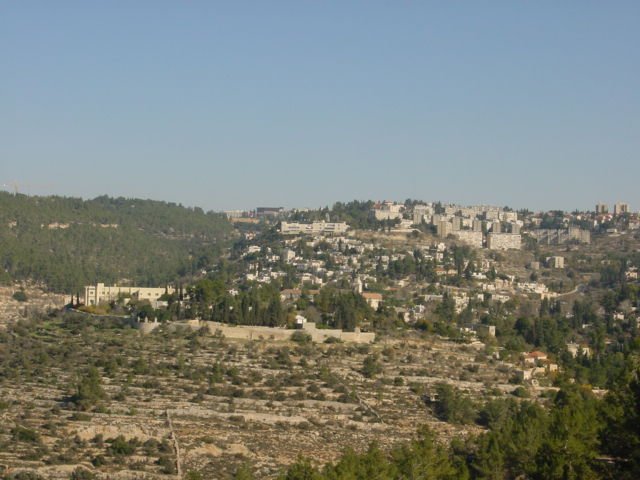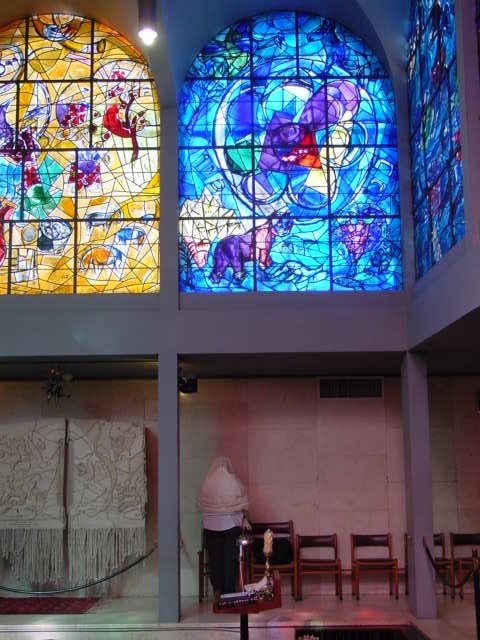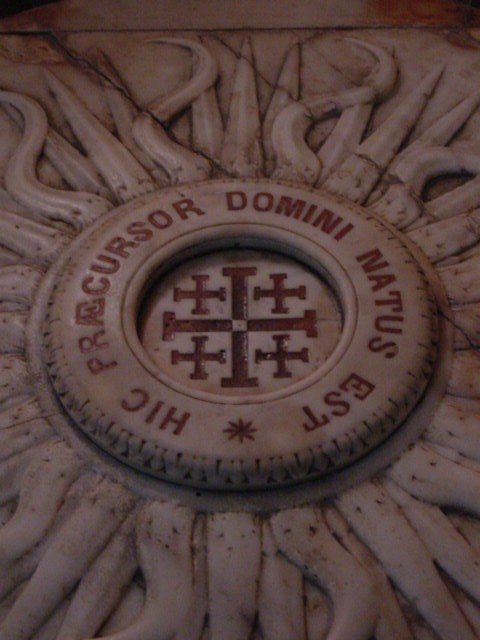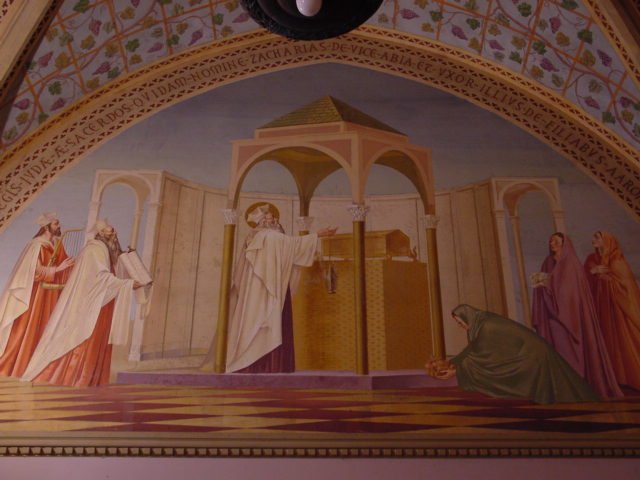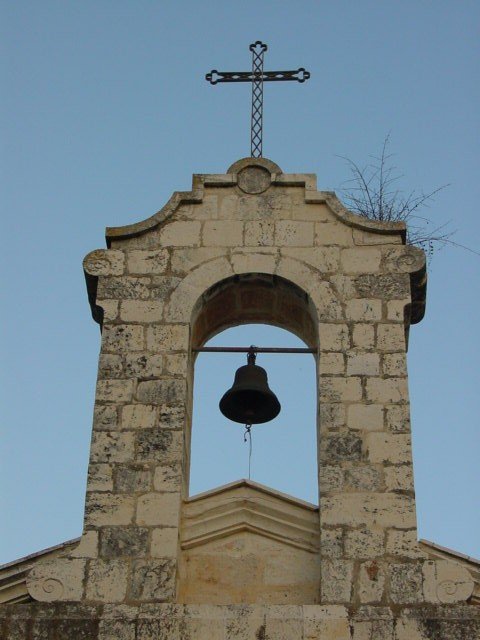December 5, 2002
Yesterday, we left for Jerusalem, hoping that today would be the 'Eid. In fact, no one was sure until last night - the actual appearance of the moon unobscured by clouds signals the end of Ramadan. In reality, it could've been tomorrow. But it's today.
Ein Kerem, Israel, once an Arab town, is the location of Hadassah Hospital
Our friends gave us a ride out to Ein Kerem to Hadassah Hospital. Elizabeth is having follow-up tests for recurring headaches (which have since abated - but better safe than sorry). This morning, it was vision tests.
Marthame waited outside, sitting and re-reading William Dalrymple's From the Holy Mountain, in which he recounts his travels through the Middle East seeing the remnants of the ancient Christian community. It is both an entertaining and depressing read - an honest telling of the situation facing a once-thriving Byzantine Christianity. Intriguingly, he suggests that the success of Islam in the Middle East hinged on its perception by many (including theologians of the time like John Damascene) as a different (or heretical) form of Christianity, rather than an entirely new religion. At the time, perhaps the leap from Byzantine Christianity to Islam seemed no greater than an Armenian Orthodox becoming a Southern Baptist today.
The striking Chagall stained glass windows in Hadassah Hospital’s chapel
As Marthame was reading, a young man sat down next to him, his right leg somewhat shriveled. He had a dramatic four-inch scar on his neck. His right eye was eerily hollow and sunken, a triangular piece of his ear missing. His right hand and right leg had what looked like burn marks. It's hard not to imagine, with scars like this and in a country like this, that this young man was one of the lucky ones - a survivor of a suicide bombing. When bombings and clashes and invasions are ranked in the currency of lives lost, it is too easy to forget the "lucky" ones, perhaps like this man, who will also always bear the scars of the conflict.
After Elizabeth's test finished, and stopping to admire the Chagall windows in the hospital's synagogue - one for each of the twelve tribes - we walked down to the village of Ein Kerem. The ancient village, until 1948 an Arab town, cut a beautiful figure - the terraced olive groves, the pine trees draping the slopes. After stopping by the closed but reconstructed village mosque, we had lunch in an outdoor cafe. It's hard not to feel uneasy in such a setting, but we enjoyed the meal nonetheless.
A marble stone to mark the birthplace of John the Baptist
Ein Kerem, Arabic for "generous spring," is known as the location of Elizabeth and Zacharias' summer home and the birthplace of John the Baptist - "the precursor of Christ." The Franciscan Convent where Marthame attended the Sabeel Clergy Retreat is built over the grotto believed to be the place where Elizabeth gave birth to John. Its style is very similar to that of the Grotto of the Nativity, what looks like a fireplace under which sits a cross marking the place.
The priest Zechariah, father of John the Baptist, receiving a vision in the Temple
We left that spot where the voice who cried in the wilderness was born. We were in search of the large monastery that beckoned us as we descended the slopes of Hadassah. We wandered back through the side streets of modern Ein Kerem, a sleepy town that felt a million miles away from the ills and uncertainties of Jenin. The town exudes an almost Alpine, European air, but we were overcome by great sadness. The Arab architecture has been carefully preserved, and is obviously greatly admired by its new inhabitants. Elegant stone buildings with arched Ottoman-style windows, domed roofs, and recessed courtyards filled the town, but there is only one Arab family left from 1948. The rest fled the War and were never allowed to return home. We felt deep sadness for what must have happened to the population here who left the place they called home, a place that only lives in their memories.
The now closed Greek Orthodox church in Ein Kerem, Israel - once home to an Arab Orthodox community
We stumbled upon a locked Greek Orthodox church which appeared to have been recently repainted. Since it was probably the parish church for the Orthodox community in 1948, it is merely left to the Patriarchate to keep up. More sadness. Winding our way through more of Ein Kerem's back streets, we came across the Sisters of Zion, a French monastery and guesthouse founded by Alphonse Ratisbonne - a 19th century Jewish convert to Catholicism. Their brochure mentions their ministry to the local Arab community "until 1948." That's it - no mention of what happened to those folks. To tell it would be perceived as political, anti-Israel. But to not tell it is equally as political, anti-Arab. Even in the brochures of guest hostels, politics intervenes.
A statue of the meeting of Elizabeth and Mary in the Franciscan Church of Visitation in Ein Kerem, Israel
On our way back up the mountain path, we visited the Franciscan Church of Visitation, where Mary and Elizabeth are purported to have met, and the infant John leapt in Elizabeth's womb. Fr. Carlos, the Argentinian caretaker, left his new puppy Rica to take us into see the grotto where the Biblical meeting traditionally took place. Elegant frescoes decorate the sanctuary, depicting Zacharias' vision, the meeting of the two mothers, and his miraculous protection during Herod's slaughter of the innocents.
We walked back to Hadassah as the sun had gone down, spending the next few hours in the waiting room for another set of tests and reading Dalrymple's travels through post-war Lebanon. Sitting next to us was an eighty-some year-old Israeli man reading a book in German. The historical imagination wonders.
We finished late, waiting for an Arab taxi driver - no Jewish drivers would go to Beit Hanina, especially at night. A long day.

